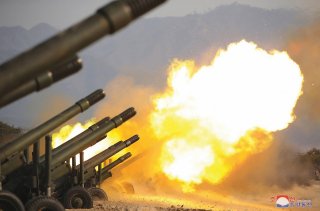Forget the Nukes: North Korea's Artillery Army Could Kill 250,000
Pyongyang's nukes are scary, but don't forget about North Korea's artillery.
Here's What You Need to Remember: In firing the artillery at the same time as it launched a ballistic missile, North Korea reminded the world of its enormous conventional firepower.
Years back, North Korea on May 4, 2019 test-fired a short-range ballistic missile -- its first major launch in the 18 months since North Korean leader Kim Jong Un suspended missile testing ahead of a summit with U.S. president Donald Trump.
Pyongyang on May 9, 2019 launched a second “projectile,” South Korean officials said.
The May tests of at least one apparently nuclear-capable short-range missile startled foreign observers and threatened to elevate tensions between the United States and its allies South Korea and Japan on one side and, on the other side, North Korea and its main patron China.
But a less dramatic test of North Korea’s heavy artillery that occured at the same time as the May 4 rocket launch arguably is more important.
“On May 4, under the watchful eye of Kim Jong Un, North Korea launched a series of projectiles featuring two types of large-caliber, multiple launch rocket systems and a new short-range ballistic missile,” Michael Elleman wrote for 38 North, a North Korea-focused think tank associated with the Washington, D.C.-based Stimson Center.
“A few days later, North Korea released photographs of tested projectiles, which provides a basis for preliminary evaluations,” Elleman continued. “The 240-millimeter and 300-millimeter diameter MLRS systems are not new to North Korea, nor do they alter the country’s battlefield capabilities.”
It’s true that Pyongyang long has operated large-caliber artillery systems. But Elleman is wrong to downplay the significance of the May 2019 artillery test. That’s because North Korea’s roughly 13,000 artillery pieces arguably pose a greater immediate threat than do Pyongyang’s nukes to South Koreans and Americans living in South Korea.
In firing the artillery at the same time as it launched a ballistic missile, North Korea reminded the world of its enormous conventional firepower. North Korea previously tested, in November 2018, upgrades to its non-nuclear artillery.
Much of Pyongyang’s artillery is in range of the Seoul Greater Metropolitan Area, which begins just 25 miles south of the Demilitarized Zone separating the two Koreas. Some 10 million people live in the Greater Seoul Metropolitan Area and another 15 million reside just outside of the metropolitan area. South Korea has prepared underground shelters for Seoul’s entire population.
“Though the expanding range of North Korea’s ballistic missiles is concerning, a serious, credible threat to 25 million [Republic of Korea] citizens and approximately 150,000 U.S. citizens living in the [Greater Seoul Metropolitan Area] is also posed from its long-range artillery.” U.S. Army general Vincent Brooks, head of U.S. Forces Korea, told a U.S. Senate committee in March 2018.
“North Korea has deployed at least three artillery systems capable of ranging targets in the [Greater Seoul Metropolitan Area] with virtually no warning,” Brooks warned. The 170-millimeter Koksan gun is the most numerous. It can fire a distance of 37 miles. North Korea also deploys truck-mounted launchers that can fire a volley of as many as 22 240-millimeter rocket out to a range of 37 miles.
The 300-millimeter KN-09 rocket artillery is the newest system. “The rocket was first tested in 2013, with subsequent tests performed in 2014 and 2016,” Elleman explained.
It has a reported range of [118 to 124 miles] and carries a light, conventional warhead. It is powered by a standard composite-type solid fuel. Photographs show that the rocket is steered during flight by four small canard fins mounted at the rocket’s front end, near the warhead section, which provides for precision strikes if the guidance unit includes a satellite navigation receiver to update the inertial navigation components.”
The KN-09 is fielded on a six-wheeled truck equipped with two launch pods, each having four launch tubes. Its primary mission is to strike rear echelon targets, some [31 to 62 miles] behind the primary line of battle.
"Even without using nuclear weapons, North Korea has the capacity to unleash a devastating level of violence against a significant portion of the ROK population through some mix of conventional artillery and possibly chemical munitions," according to a January 2019 report from RAND, a California think tank with close ties to the U.S. military.
A North Korean artillery barrage could inflict as many as 250,000 casualties in Seoul alone, RAND reported, citing a U.S. Defense Department estimate.
David Axe was Defense Editor of the National Interest. He is the author of the graphic novels War Fix, War Is Boring and Machete Squad. This article is being republished due to reader interest.
Image: Reuters.

